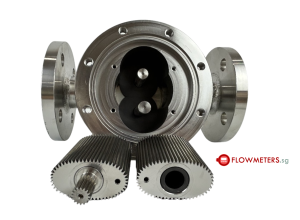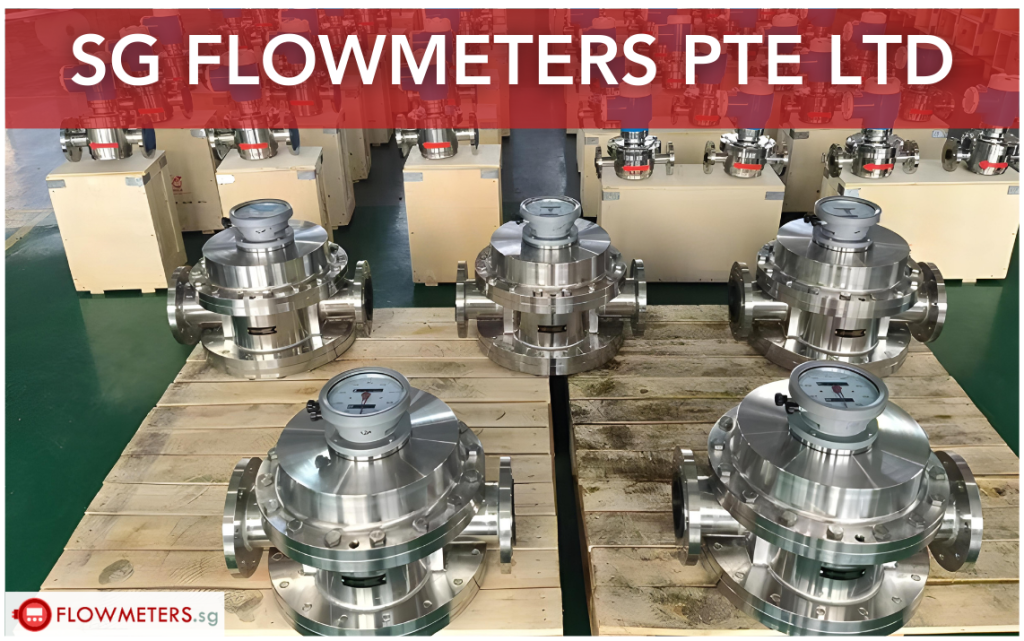An Oval Gear Flow Meter is a mechanical type of meter that works by the positive displacement principle. Oval Gear Meters are popular and cost-effective method to measure fuel and oil e.g. Diesel Fuel.

The term “Oval Gear” describes the shape of the pieces that are literally part of the rotor. There are two oval shaped rotors that are fixed into a chamber which is covered by the body of the meter. As liquid passes through from one side to the other, the gears rotate. Each rotation represents a fixed volume of liquid that passes through the meter. Various options allow the user to see the flow rate and total volume over a time period.
The Oval Gear Meter is not the only type of PD Meter but this technique using oval gears has become popular because this design is good for precision measurement. Those who are familiar with pumps will know that viscous fluids work better with gear pumps – the same applies to flow measurements of viscous liquids. Oval Gear Meters are common sight in chemical plants, marine, hydraulic applications, syrups, and certain heavy fuel.
How do Oval Gear Flow Meters work?
The Oval gear animation explains clearly how a direct volumetric reading is obtained. Two precision manufactured oval geared rotors are spinning inside the meter body. The liquid enters the rotor chamber, and a precise volume fills the voids between the elliptical gears. Since the clearance is tight, it means that no leakage is present between the gear spaces which enables accurate displacements of liquid volumes.
The Oval Gear rotate at the same speed as each other and these rotations can be counted using mechanical and electronic methods.
Applications
- Heavy Fuel Oil (HFO)
- Diesel Oil
- Lubricating Oil
- Paints
- Resins
- Chemicals
Advantages of Oval Gear Meter
- Generally, an Oval Gear Flow Meter will have an inherent accuracy of 0.5% and even 0.2% when needed and is considered to be a precise method of liquid measurement, especially for chemicals and fuels.
- Totally independent of viscosity. There is no need for the Oval Gear Flow Meter to use inferential methods of flow rate calculations that depend on Reynolds numbers. The direct volume measurement principle works with either thick (High Density) or thin (Low Density) oil, fuel and chemicals.
- There is no requirement for minimum upstream and downstream lengths in Oval Gear Meter installations.
- Due to the Oval Gear rotors, chamber and complete body sturdy mechanical properties, there is no, or very little chance of flow measurement drift linked to vibration.
- One of the beauties in using the Oval Gear Flow Meter is the fact that electric power is not required for it to operate and measure flow.
- With standard and optional flow counters (mechanical registers) it is possible to measure not only total historical flow accumulation but also batch flows by simply resetting one of the counters.
- Where needed, the Oval Gear Flow Meter can also be configured and coupled with a digital display, analog and pulse outputs as well as other industry standard protocols for signalling and reporting flow consumption to control rooms or remote locations.
Recommendations for Potential Oval Gear Meter Buyers
- These meters are very bulky and although economically priced, much of the cost goes towards shipping the item. Knowing this, customers should plan for a gear flow meter installation well in advance in order to save costs. Although an alternative is using a cheaper propeller type flow meter, the Oval Gear Flow Meter has an overall lower cost of ownership due to its design which is superior to many other types of standard flow meters.
- To ensure a greater lifetime of an Oval Gear Meter it is always advisable for the user to invest in a strainer before the inlet of the meter. Since not all diesels might be clean, the strainer will remove particles that cause unnecessary wear on the precision machined gears.
How to order from us:
If you have a specification of an existing gear meter, we can supply a “like for like” or equivalent meter.
The information that is generally required is:
- Fluid to be measured e.g. diesel.
- Flow range: e.g. 10 GPM (2.28) or m³/hr.
- Operating pressure 160psi
- Connection size e.g. 25mm or ANSI Flange
- Body Material: Cast Iron, Stainless Steel etc.
- Internal parts materials
- Temperature range 0-80 Deg. C
- Accuracy: 1%
- Display registers e.g. mechanical type with reset counter.














